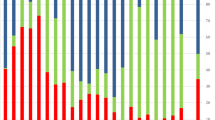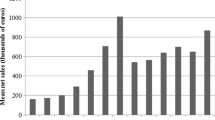Abstract
Using a self-collected longitudinal dataset that comprehends the population of academic spinoffs created in Portugal from 1995 until 2007 we investigate to what extent these firms are geographically clustered and the determinants of their geographical distribution at the time of their formation. We focus on university and agglomeration economies-related mechanisms at the municipality level. Our results show that overall academic spinoffs do not exhibit a tendency to cluster, nevertheless some local clusters do exist. Additionally, our findings show that the presence of university incubators and/or university research parks is the most relevant university-related mechanism, whereas regarding agglomeration economies all seem to be important to explain academic spinoffs distribution across municipalities.


Similar content being viewed by others
Notes
If we consider the transition probabilities from 1 year to the next for the entry of spinoffs we observe that the zero outcome has a high probability (84.3 %) of remaining zero, but when the number of spinoffs entry is four or more in a given municipality, then the probability of having four or more spinoffs in that municipality in the next year is as high as 53.3 %. For simplicity we do not present these results, but they are available upon request to the authors. .
References
Abramovsky, L., Harrison, R., & Simpson, H. (2007). University research and the location of business R&D. The Economic Journal, 117, C114–C141.
Acosta, M., Coronado, D., & Flores, E. (2011). University spillovers and new business location in high-technology sectors: Spanish evidence. Small Business Economics, 36(3), 365–376.
Acs, Z., Audretsch, D., Pontus, B., & Carlsson, B. (2009). The knowledge spillover theory of entrepreneurship. Small Business Economics, 32(1), 15–30.
Aghion, P., Blundell, R., Griffth, R., Howitt, P., & Prantl, S. (2009). The effects of entry on incumbent innovation and productivity. The Review of Economics and Statistics, 91(1), 20–32.
Armington, C., & Acs, Z. (2002). The determinants of regional variation in new firm formation. Regional Studies, 36(1), 33–45.
Asterbo, T., & Bazzazian, N. (2011). Universities, entrepreneurship and local economic development. In M. Fritsch (Ed.), Handbook of research on entrepreneurship and regional development (pp. 252–333). Cheltenham: Edward Elgar.
Audretsch, D., & Feldman, M. (2004). Knowledge spillovers and the geography of innovation. In V. Henderson & J. F. Thiesse (Eds.), Handbook of regional and urban economics (pp. 2713–2739). Amsterdam: North Holland Publishing.
Audretsch, D., Lehmann, E., & Warning, S. (2004). University spillovers: does the kind of science matter and new firm location. Industry and Innovation, 11, 193–205.
Audretsch, D., Lehmann, E., & Warning, S. (2005). University spillovers and new firm location. Research Policy, 34(7), 1113–1122.
Audretsch, D., & Stephan, P. (1996). Company-scientist locational links: the case of biotechnology. The American Economic Review, 86(3), 641–652.
Baptista, R., & Mendonça, J. (2010). Proximity to knowledge sources and the location of knowledge-based start-ups. Annals of Regional Science, 45, 5–29.
Bonaccorsi, A., Colombo, M., Guerini, M., & Rossi-Lamastra, C. (2013). University specialization and new firm creation across industries. Small Business Economics, 41, 837–863.
Buenstorf, G., & Geissler, M. (2011). The origins of entrants and the geography of German laser industry. Papers in Regional Science, 90, 251–270.
Calcagnini, G., Favaretto, I., Giombini, G., Perugini, F., & Rombaldoni, R. (2016). The role of universities in the location of innovative start-ups. The Journal of Technology Transfer, 41(4), 670–693.
Cameron, A., & Trivedi, P. (1998). Regression analysis of count data. Cambridge: Cambridge University Press.
Casper, S. (2013). The spill-over theory reversed: the impact of regional economies on the commercialization of university science. Research Policy, 42, 1313–1324.
Clarysse, B., Tartari, V., & Salter, A. (2011). The impact of entrepreneurial capacity, experience and organizational support on academic entrepreneurship. Research Policy, 40, 1084–1093.
Cohen, W., & Levinthal, D. (1989). Innovation and learning: the two faces of R&D. The Economic Journal, 99, 569–596.
Colombo, M., & Delmastro, M. (2002). How effective are technology incubators? Evidence from Italy. Research Policy, 31, 1103–1122.
Colombo, M., & Piva, E. (2012). Firms’ genetic characteristics and competence-enlarging strategies: a comparison between academic and non-academic high-tech start-ups. Research Policy, 41, 79–92.
Di Gregorio, D., & Shane, S. (2003). Why do some universities generate more start-ups than others? Research Policy, 32, 209–227.
Druilhe, C., & Garnsey, E. (2004). Do academic spin-outs differ and does it matter? Journal of Technology Transfer, 29, 269–285.
Egeln, J., Gottschalk, S., & Rammer, C. (2004). Location decisions of spinoffs from public research institutions. Industry and Innovation, 11(3), 207–223.
Ellison, G., Glaeser, E., & Kerr, W. (2010). What causes industry agglomeration? Evidence from coagglomeration patterns. American Economic Review, 100, 1195–1213.
Fernández-Alles, M., Camelo-Ordaz, C., & Franco-Leal, N. (2015). Key resources and actors for the evolution of academic spin-offs. Journal of Technology Transfer, 40, 976–1002.
Figueiredo, O., Guimarães, P., & Woodward, D. (2002). Home-field advantage: location decisions of Portuguese entrepreneurs. Journal of Urban Economics, 52(3), 41–361.
Fini, R., Grimaldi, R., Santoni, S., & Sobrero, M. (2011). Complements or substitutes? The role of universities and local context in supporting the creation of academic spinoffs. Research Policy, 40(8), 1113–1127.
Fontes, M. (2005). Distant networking: the knowledge acquisition strategies of ‘out-cluster’ biotechnology firms. European Planning Studies, 13(6), 899–920.
Frenken, K., Cefis, E., & Stam, E. (2015). Industrial dynamics and clusters: a survey. Regional Studies, 49(1), 10–27.
Friedman, J., & Silberman, J. (2003). University technology transfer: do incentives management, and location matter? Journal of Technology Transfer, 28(1), 17–30.
Fritsch, M., & Aamoucke, R. (2013). Regional public research, higher education, and innovative start-ups: an empirical investigation. Small Business Economics, 41(4), 865–885.
Greene, W. (2008). Econometric analysis. New Jersey: Pearson Education.
Guimarães, P., Figueiredo, O., & Woodward, D. (2000). Agglomeration and the location of foreign direct investment in Portugal. Journal of Urban Economics, 47, 115–135.
Hall, B., Link, A., & Scott, J. (2003). Universities as research partners. Review of Economics and Statistics, 85(2), 485–491.
Hausman, J., Hall, B., & Griliches, Z. (1984). Economic models for count data with an application to the patents-R&D relathionship. Econometrica, 52, 909–938.
Heblich, S., & Slavtchev, V. (2013). Parent universities and the location of academic startups. Small Business Economics, 42, 1–15.
Heirman, A., & Clarysse, B. (2004). How and why do research-based start-ups differ at founding? A resource-based configurational perspective. Journal of Technology Transfer, 29, 247–268.
Jaffe, A. (1989). Real effects of academic research. The American Economic Review, 79, 957–970.
Kim, Y., Kim, W., & Yang, T. (2012). The effect of the triple helix system and habitat on regional entrepreneurship: empirical evidence from the U.S. Research Policy, 41, 154–166.
Klepper, S. (2007). Disagreements, spinoffs, and the evolution of Detroit as the capital of the U.S. automobile industry. Management Science, 53, 616–631.
Lach, S., & Schankerman, M. (2008). Incentives and invention in universities. Rand Journal of Economics, 39(2), 403–433.
Link, A., & Scott, J. (2005). Opening the ivory tower’s door: an analysis of the determinants of the formation of U.S. university spinoff companies. Research Policy, 34(7), 1106–1112.
Lockett, A., & Wright, M. (2005). Resources, capabilities, risk capital and the creation of university spinoff companies. Research Policy, 34(7), 1043–1057.
Lofsten, H., & Lindelof, P. (2005). R&D networks and product innovation patterns—academic and non-academic new technology-based firms on Science Parks. Technovation, 25, 1025–1037.
Marshall, A. (1920). Principles of economics. London: Macmillan.
Matias, S., & Fontes, M. (2013). Policies to Foster the Creation of Research-Based Spinoffs in Portugal, DINÂMIA’CET-Working Papers, 2013/15. Lisboa: DINAMIA´CET.
Mazzoleni, R., & Nelson, R. (2007). Public research institutions and economic catch-up. Research Policy, 36(10), 1512–1528.
Mustar, P., Renault, M., Colombo, M., Piva, E., Fontes, M., Lockett, A., et al. (2006). Conceptualising the heterogeneity of research-based spinoffs: a multi-dimensional taxonomy. Research Policy, 35, 289–308.
Nelson, R. (1986). Institutions supporting technical advance in industry. The American Economic Review, 76(2), 186–189.
O’Shea, R., Allen, T., Chevalier, A., & Roche, F. (2005). Entrepreneurial orientation, technology transfer and spinoff performance of U.S. universities. Research Policy, 34(7), 994–1009.
Pfeiffer, D. U., Tobinson, T. P., Stevenson, M., Stevens, K. B., Rogers, D. J., & Clements, A. C. A. (2008). Spatial analysis in epidemiology. Oxford: Oxford University Press.
Piva, E., Grilli, L., & Rossi-Lamastra, C. (2011). The creation of high-tech entrepreneurial ventures at the local level: the role of local competences and communication infrastructures. Industry and Innovation, 18(6), 563–580.
Poyago-Theotoky, J., Beath, J., & Siegel, D. (2002). Universities and fundamental research: reflections on the growth of university-industry partnerships. Oxford Review of Economic Policy, 18(1), 10–21.
Schumpeter, J. (1934). The Theory of Economic Development. Harvard University Press: Cambridge (New York: Oxford University Press, 1961). First published in German, 1912.
Shane, S. (2004). Academic entrepreneurship: university spinoffs and wealth creation. Cheltenham: Edward Elgar.
Sorenson, O., & Audia, P. (2000). The social structure of entrepreneurial activity: geographic concentration of footwear production in the United States, 1940–1989. American Journal of Sociology, 106, 424–462.
Sousa, C., Fontes, M., & Videira, P. (2011). The role of entrepreneurs’ social networks in the creation and early development of biotechnology companies. International Journal of Entrepreneurship and Small Business, 12(2), 227–244.
Stam, E. (2010). Entrepreneurship, Evolution and Geography. In R. Boschma & R. L. Martin (Eds.), Handbook of evolutionary economic geography (pp. 307–348). Cheltenham: Edward Elgar.
Thompson, W. (1968). Internal and external factors in urban economies. In H. Perloff & L. Wingo (Eds.), Issues in urban economics (pp. 43–62). Baltimore: Johns Hopkins University Press and Resources for the Future.
Van Looy, B., Landoni, P., Callaert, J., van Pottelsberghe, B., Sapsalis, E., & Bebackere, K. (2011). Entrepreneurial effectiveness of European universities: an empirical assessment of antecedents and trade-offs. Research Policy, 40, 553–564.
Woodward, D., Figueiredo, O., & Guimarães, P. (2006). Beyond the Silicon Valley: university R&D and high-technology location. Journal of Urban Economics, 60, 15–32.
Wright, M., Clarysse, B., & Mosey, S. (2012). Strategic entrepreneurship, resource orchestration and growing spinoffs from universities. Technology Analysis & Strategic Management, 24(9), 911–927.
Wright, M., Clarysse, B., Mustar, P., & Lockett, A. (2007). Academic entrepreneurship in Europe. Cheltenham: Edward Elgar.
Author information
Authors and Affiliations
Corresponding author
Rights and permissions
About this article
Cite this article
Conceição, O., Faria, A.P. & Fontes, M. Regional variation of academic spinoffs formation. J Technol Transf 42, 654–675 (2017). https://doi.org/10.1007/s10961-016-9508-1
Published:
Issue Date:
DOI: https://doi.org/10.1007/s10961-016-9508-1




